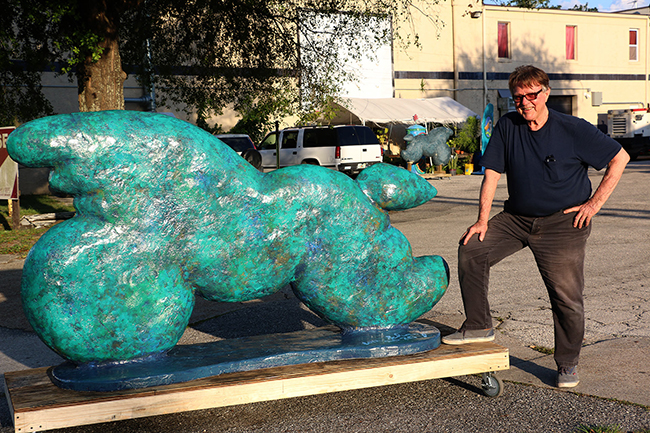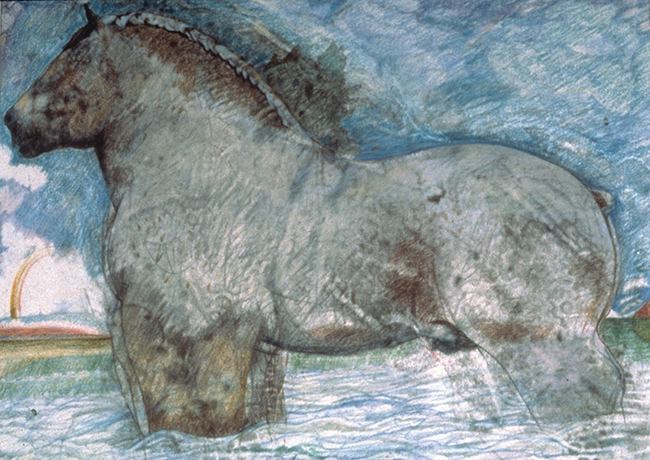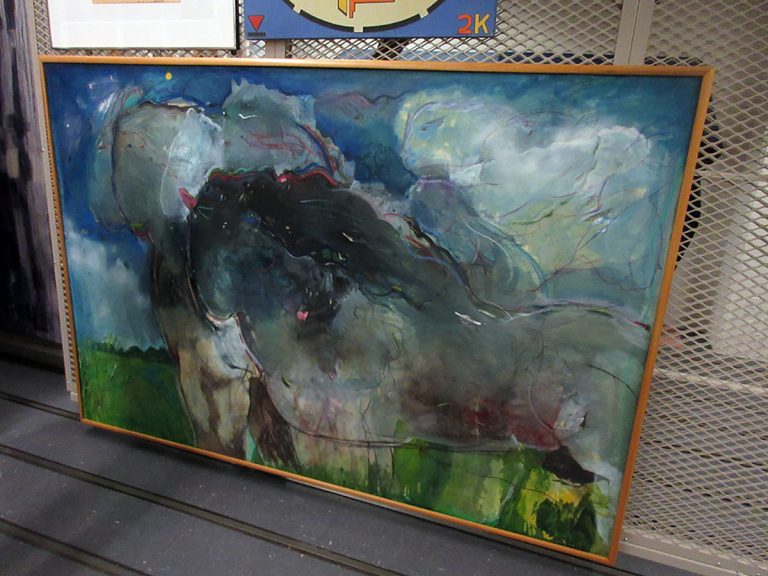At 80 years old, William Schaaf is still moving forward. He’s been at it for sixty years—painting and sculpting horses, always returning to them like a compass needle to north. His work is physical, emotional, and often spiritual. It’s about connection. With nature, with himself, and with the cultures that have inspired him deeply—particularly the Zuni and Navajo, whose fetishes and dolls taught him that small things can hold big meaning.
Schaaf’s horses don’t gallop across wide canvases or leap from polished pedestals. They stand solid, often still. Weighty. Present. Whether in drawing or sculpture, they carry the marks of memory and meditation. The horse is not just an animal to Schaaf—it’s a symbol, a vessel, a way in. He’s never cared much for fashion in art. He’s cared about using it to heal, to process, and to reach something honest.
Rescue Horse (Sculpture, Cast Concrete, COVID-Era)

During COVID, Schaaf found himself returning to the equine form again, but this time on a larger scale. Rescue Horse was born out of the chaos and uncertainty of the time, a cast concrete sculpture in bold, deep blue-green hues. It’s heavy, solid, and oddly joyful for something born out of global anxiety. This horse doesn’t look like it’s running—it looks like it’s holding ground.
The work was a collaboration with Jeff Whipple, Schaaf’s friend of over 50 years. “Really, he did most of it,” Schaaf says, with the kind of honesty and humility that comes from decades of making and growing. Whipple brought technical skill and fresh energy to the piece; Schaaf brought his lifelong emotional tether to the subject. Together, they created what Schaaf now calls “our largest Talisman.” That word—talisman—is important. It’s how Schaaf sees many of his works: as objects holding spiritual or emotional weight.
Placed on a mobile wooden base, Rescue Horse feels like it’s in transition—not just physically, but symbolically. It’s a marker of time, of survival, of collaboration when isolation was the norm. Its bulk, its color, and its texture carry you somewhere else—somewhere familiar, animal, and slightly mystical. There’s a second, smaller version of it in the background of one image. It’s as if these horses travel in pairs, like guardian spirits.
Great Horse (Drawing)

Where Rescue Horse is grounded in mass and matter, Great Horse—a large drawing—moves in a different direction. It’s quieter. The lines are soft, and the horse itself is almost transparent, as if pulled between worlds. The body takes up nearly the whole space, but it doesn’t dominate. It hums. This is not a sketch of anatomy or power. It’s a presence.
The palette is mostly subdued: blues, greys, soft browns. The background feels like sky and water blended into one. A faint rainbow arcs behind the horse. The whole piece leans toward myth. It’s not flashy or overly rendered. It just is, like the horses Schaaf sees in his mind’s eye.
You can feel Schaaf in the drawing—his patience, his softness, his years of looking and remembering. It’s not trying to impress. It’s trying to connect. Like all his equine work, it’s less about what the horse is doing and more about what it means.
The Work Behind the Work
Schaaf doesn’t pretend to be someone who controls the process. He shows up, he listens, and he lets the work become what it needs to. Horses have offered him a kind of mirror for decades—one that reflects pain, joy, history, and healing.
He talks about “fixing himself up” through art. That’s not a metaphor to him. It’s real. Making art has been how he deals with the things that don’t make sense. How he honors the cultures that gave him grounding. How he explores what it means to be alive, aging, and still creating.
The horse—whether in blue concrete or soft pastel—isn’t a subject. It’s a path.
And William Schaaf is still walking it.


